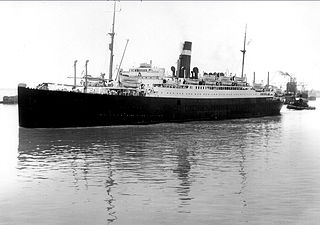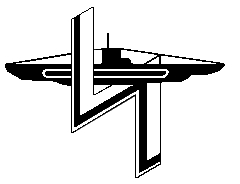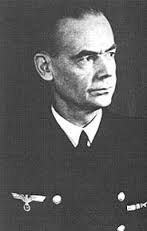
Karl Dönitz was a German admiral who briefly succeeded Adolf Hitler as head of state in May 1945, holding the position until the dissolution of the Flensburg Government following Germany's unconditional surrender to the Allies days later. As Supreme Commander of the Navy beginning in 1943, he played a major role in the naval history of World War II.

The Kriegsmarine was the navy of Nazi Germany from 1935 to 1945. It superseded the Imperial German Navy of the German Empire (1871–1918) and the inter-war Reichsmarine (1919–1935) of the Weimar Republic. The Kriegsmarine was one of three official branches, along with the Heer and the Luftwaffe, of the Wehrmacht, the German armed forces from 1935 to 1945.

The Laconia incident was a series of events surrounding the sinking of a British passenger ship in the Atlantic Ocean on 12 September 1942, during World War II, and a subsequent aerial attack on German and Italian submarines involved in rescue attempts. RMS Laconia, carrying 2,732 crew, passengers, soldiers, and prisoners of war, was torpedoed and sunk by U-156, a German U-boat, off the West African coast. Operating partly under the dictates of the old prize rules, the U-boat's commander, Korvettenkapitän Werner Hartenstein, immediately commenced rescue operations. U-156 broadcast her position on open radio channels to all Allied powers nearby, and was joined by the crews of several other U-boats in the vicinity.

U-boats were naval submarines operated by Germany, particularly in the First and Second World Wars. The term is an anglicised version of the German word U-Boot, a shortening of Unterseeboot, though the German term refers to any submarine. Austro-Hungarian Navy submarines were also known as U-boats.

The London Naval Treaty, officially the Treaty for the Limitation and Reduction of Naval Armament, was an agreement between the United Kingdom, Japan, France, Italy, and the United States that was signed on 22 April 1930. Seeking to address issues not covered in the 1922 Washington Naval Treaty, which had created tonnage limits for each nation's surface warships, the new agreement regulated submarine warfare, further controlled cruisers and destroyers, and limited naval shipbuilding.

The Second London Naval Treaty was an international treaty signed as a result of the Second London Naval Disarmament Conference held in London, the United Kingdom. The conference started on 9 December 1935 and the treaty was signed by the participating nations on 25 March 1936.

The Hague Conventions of 1899 and 1907 are a series of international treaties and declarations negotiated at two international peace conferences at The Hague in the Netherlands. Along with the Geneva Conventions, the Hague Conventions were among the first formal statements of the laws of war and war crimes in the body of secular international law. A third conference was planned for 1914 and later rescheduled for 1915, but it did not take place because of the start of World War I.

Unrestricted submarine warfare is a type of naval warfare in which submarines sink merchant ships such as freighters and tankers without warning. The use of unrestricted submarine warfare has had significant impacts on international relations in regards to both the First World War and the Second World War. Its history has been dominated by German decision making.

SS Athenia was a steam turbine transatlantic passenger liner built in Glasgow, Scotland, in 1923 for the Anchor-Donaldson Line, which later became the Donaldson Atlantic Line. She worked between the United Kingdom and the east coast of Canada until 3 September 1939, when a torpedo from the German submarine U-30 sank her in the Western Approaches.
Plan Z was the name given to the planned re-equipment and expansion of the Kriegsmarine ordered by Adolf Hitler in early 1939. The fleet was meant to challenge the naval power of the United Kingdom, and was to be completed by 1948. Development of the plan began in 1938, but it reflected the evolution of the strategic thinking of the Oberkommando der Marine over the two decades following World War I. The plan called for a fleet centered on ten battleships and four aircraft carriers which were intended to battle the Royal Navy. This force would be supplemented with numerous long-range cruisers that would attack British shipping. A relatively small force of U-boats was also stipulated.

The German submarine U-156 was a Type IXC U-boat of Nazi Germany's Kriegsmarine built for service during World War II. The keel for this boat was laid on 11 October 1940 at the DeSchiMAG AG Weser yard in Bremen, Germany, as yard number 998. She was commissioned on 4 September 1941 under the command of Kapitänleutnant Werner Hartenstein. The city of Plauen, Hartenstein's home city, adopted the submarine within the then popular sponsorship programme (Patenschaftsprogramm), organising gifts and holidays for the crew.
German submarine U-30 was a Type VIIA U-boat of Nazi Germany's Kriegsmarine that served during World War II. She was ordered in April 1935 in violation of the Treaty of Versailles, which prevented the construction and commissioning of any U-boats for the German navy, and as part of the German naval rearmament program known as Plan Z. She sank the liner SS Athenia (1922) on 3 September 1939, under the command of Fritz-Julius Lemp. She was retired from front-line service in September 1940 after undertaking eight war patrols, having sunk 17 vessels and damaging two others. U-30 then served in a training role until the end of the war when she was scuttled. She was later raised and broken up for scrap in 1948.

Otto Heinrich Kranzbühler was a German naval judge who represented defendant Grand Admiral Karl Dönitz before the International Military Tribunal at the Nuremberg Trials.
The Laconia Order was issued by Großadmiral Karl Dönitz during World War II as a result of the Laconia incident, forbidding the rescue of any survivors.

Allied submarines were used extensively during the Pacific War and were a key contributor to the defeat of the Empire of Japan.

Fritz-Julius Lemp was a captain in the Kriegsmarine during World War II and commander of U-28, U-30 and U-110.

Eberhard Godt was a German naval officer who served in both World War I and World War II, eventually rising to command the Kriegsmarine's U-boat operations.

Gerhard Wagner was a German naval officer who ended his career as a Konteradmiral of the German Navy of West Germany.
Cruiser rules, alternatively called prize rules is a colloquial phrase referring to the conventions regarding the attacking of a merchant ship by an armed vessel. Here cruiser is meant in its original meaning of a ship sent on an independent mission such as commerce raiding. A cruiser in modern naval terminology refers to a type of ship rather than its mission. Cruiser rules govern when it is permissible to open fire on an unarmed ship and the treatment of the crews of captured vessels, and are contrasted to unrestricted submarine warfare where submarines attack without warning and do not act to protect crew.
Erich Johann Albert Raeder was a naval leader in Germany before and during World War II. Raeder attained the highest possible naval rank – that of Großadmiral – in 1939, becoming the first person to hold that rank since Henning von Holtzendorff. Raeder led the Kriegsmarine for the first half of the war; he resigned in 1943 and was replaced by Karl Dönitz. He was sentenced to life in prison at the Nuremberg Trials, but was released early due to failing health.